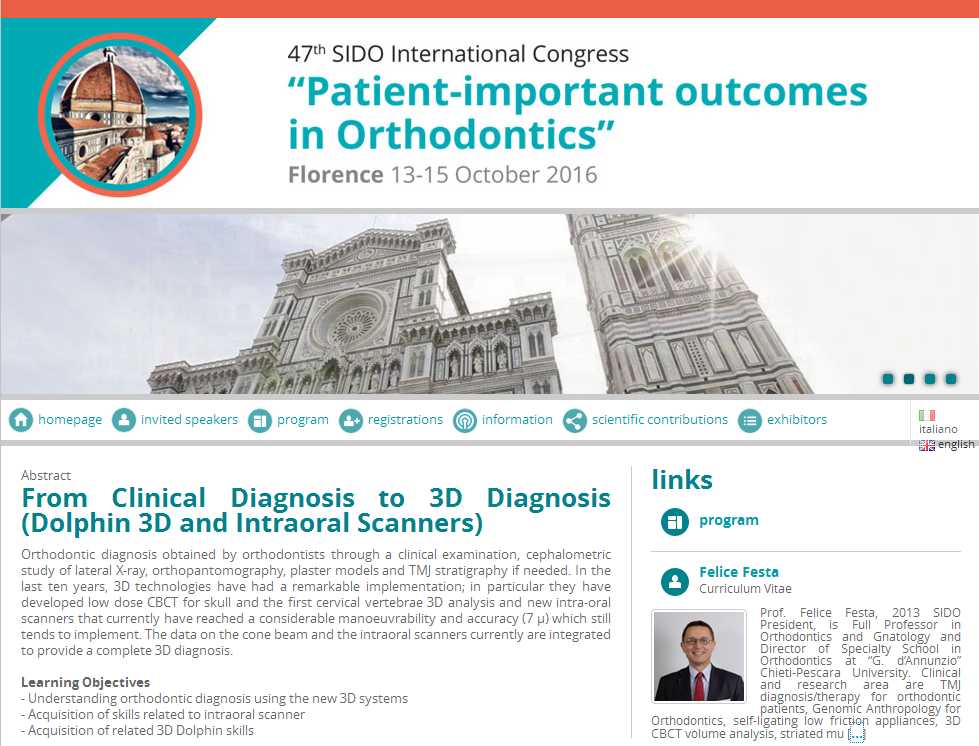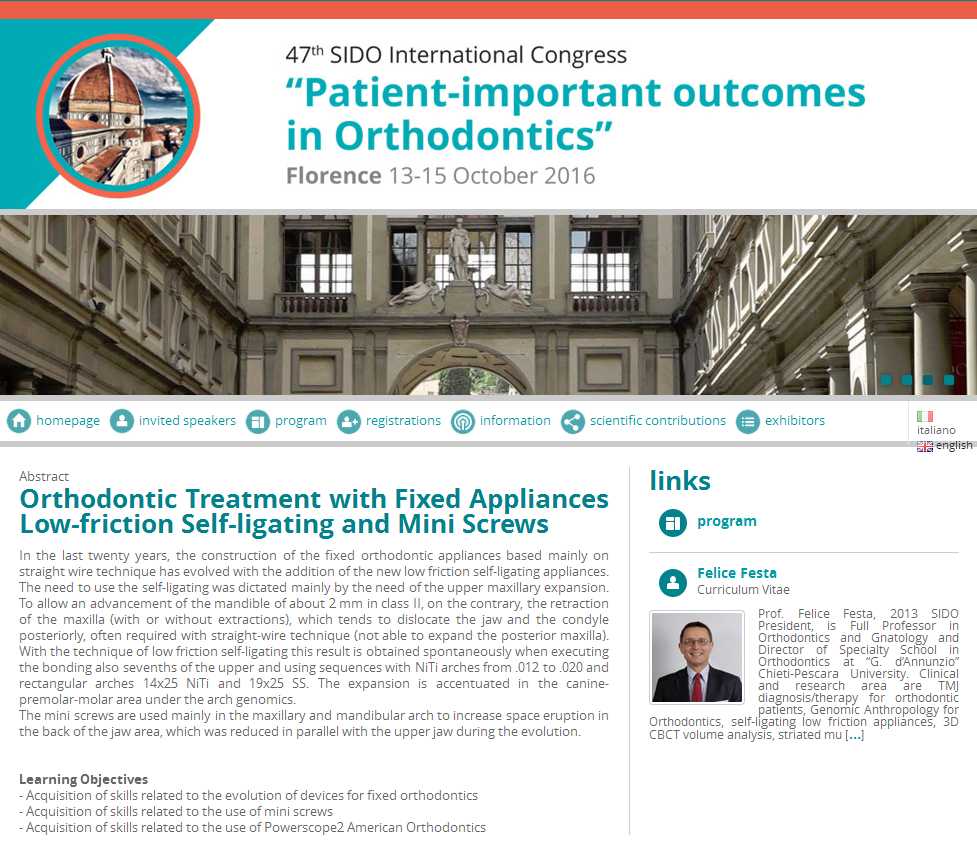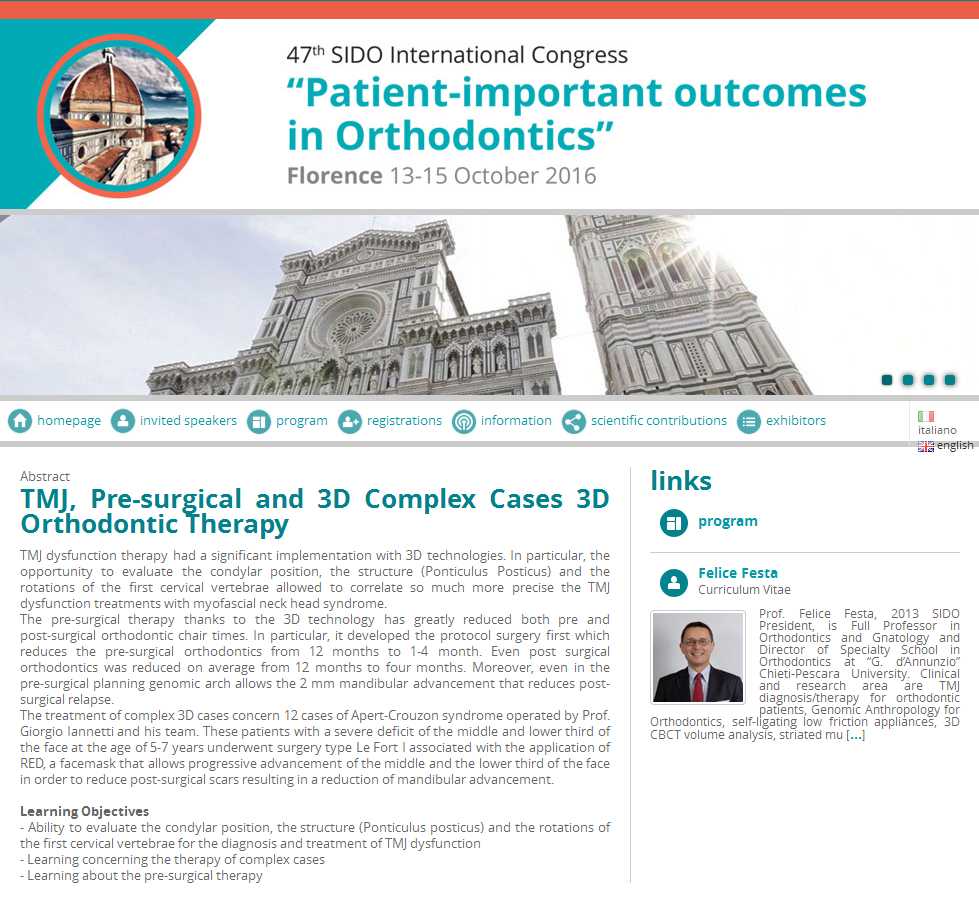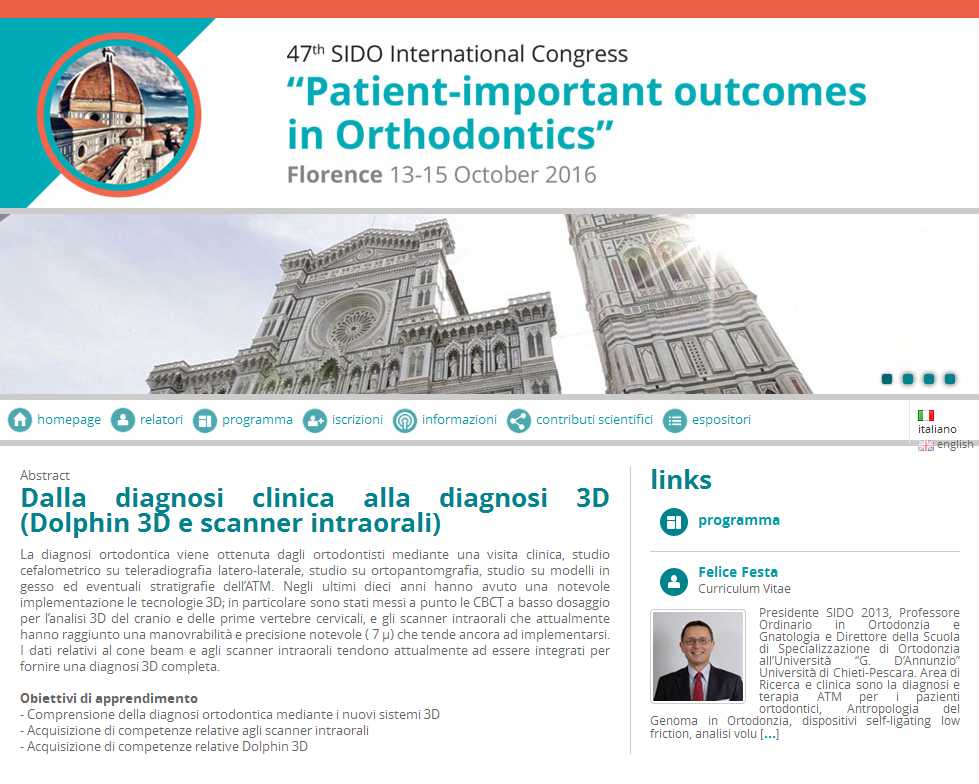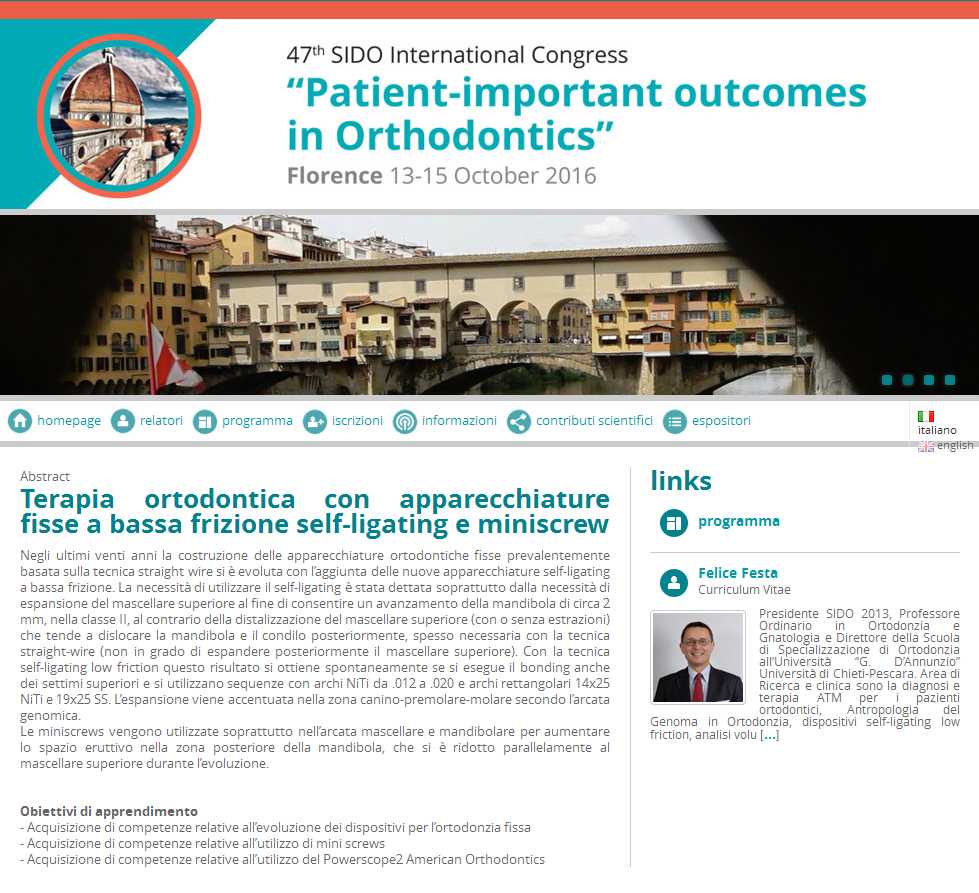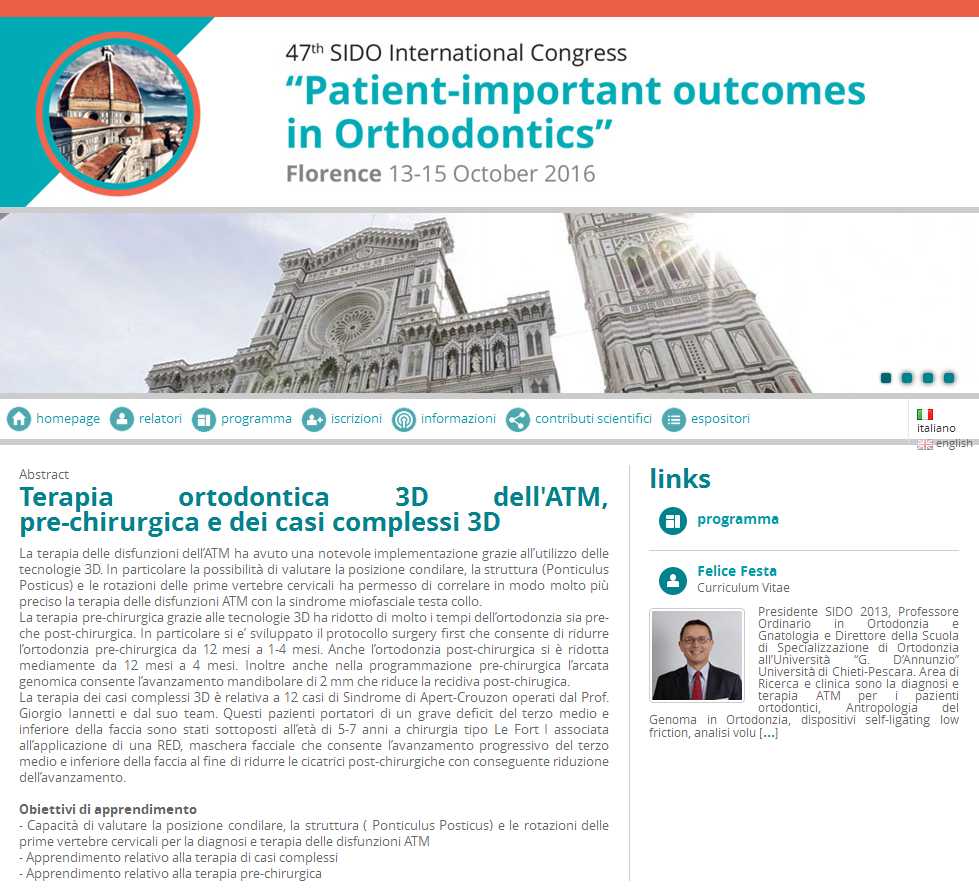47° Congresso Internazionale SIDO 13 - 15 Ottobre 2016 - Firenze

New Therapeutic Tools in Orthodontics - Tendenze nell'Ortodonzia 3D
Evento ECM per Odontoiatri / Medici-Chirurghi n. 4927-168041
Prof. Dott. F. Festa Lectures in 47° SIDO International Congress
Presidente SIDO 2013, Professore Ordinario in Ortodonzia e Gnatologia e Direttore della Scuola di Specializzazione di Ortodonzia all’Università “G. D’Annunzio” Università di Chieti-Pescara. Area di Ricerca e clinica sono la diagnosi e terapia ATM per i pazienti ortodontici, Antropologia del Genoma in Ortodonzia, dispositivi self-ligating low friction, analisi volumetrica 3D CBCT, cellule staminali della muscolatura striata. Ha scritto più di 100 articoli su riviste internazionali e varie monografie. Il Prof. Festa è ‘Past Co-Editor di Progress in Orthodontics (PIO) e European Journal of Clinical Orthodontics (EJCO). Direttore del Master in ATM, Ortodonzia e Tecnologie Digitali.
Prof. Felice Festa, 2013 SIDO President, is Full Professor in Orthodontics and Gnatology and Director of Specialty School in Orthodontics at “G. d’Annunzio” Chieti-Pescara University. Clinical and research area are TMJ diagnosis/therapy for orthodontic patients, Genomic Anthropology for Orthodontics, self-ligating low friction appliances, 3D CBCT volume analysis, striated muscle stem cells. He has written over 100 papers on international journals and a number of monographs. Prof. Festa is Past Co-Editor of Progress in Orthodontics (PIO) and European Journal of Clinical Orthodontics (EJCO). Director of Master in TMJ, Orthodontics and Digital Technologies.
Dalla diagnosi clinica alla diagnosi 3D (Dolphin 3D e scanner intraorali)
From Clinical Diagnosis to 3D Diagnosis (Dolphin 3D and Intraoral Scanners)
![]() La diagnosi ortodontica viene ottenuta dagli ortodontisti mediante una visita clinica, studio cefalometrico su teleradiografia latero-laterale, studio su ortopantomgrafia, studio su modelli in gesso ed eventuali stratigrafie dell’ATM. Negli ultimi dieci anni hanno avuto una notevole implementazione le tecnologie 3D; in particolare sono stati messi a punto le CBCT a basso dosaggio per l’analisi 3D del cranio e delle prime vertebre cervicali, e gli scanner intraorali che attualmente hanno raggiunto una manovrabilità e precisione notevole ( 7 µ) che tende ancora ad implementarsi. I dati relativi al cone beam e agli scanner intraorali tendono attualmente ad essere integrati per fornire una diagnosi 3D completa.
La diagnosi ortodontica viene ottenuta dagli ortodontisti mediante una visita clinica, studio cefalometrico su teleradiografia latero-laterale, studio su ortopantomgrafia, studio su modelli in gesso ed eventuali stratigrafie dell’ATM. Negli ultimi dieci anni hanno avuto una notevole implementazione le tecnologie 3D; in particolare sono stati messi a punto le CBCT a basso dosaggio per l’analisi 3D del cranio e delle prime vertebre cervicali, e gli scanner intraorali che attualmente hanno raggiunto una manovrabilità e precisione notevole ( 7 µ) che tende ancora ad implementarsi. I dati relativi al cone beam e agli scanner intraorali tendono attualmente ad essere integrati per fornire una diagnosi 3D completa.
Obiettivi di apprendimento
- Comprensione della diagnosi ortodontica mediante i nuovi sistemi 3D
- Acquisizione di competenze relative agli scanner intraorali
- Acquisizione di competenze relative Dolphin 3D
![]() Orthodontic diagnosis obtained by orthodontists through a clinical examination, cephalometric study of lateral X-ray, orthopantomography, plaster models and TMJ stratigraphy if needed. In the last ten years, 3D technologies have had a remarkable implementation; in particular they have developed low dose CBCT for skull and the first cervical vertebrae 3D analysis and new intra-oral scanners that currently have reached a considerable manoeuvrability and accuracy (7 µ) which still tends to implement. The data on the cone beam and the intraoral scanners currently are integrated to provide a complete 3D diagnosis.
Orthodontic diagnosis obtained by orthodontists through a clinical examination, cephalometric study of lateral X-ray, orthopantomography, plaster models and TMJ stratigraphy if needed. In the last ten years, 3D technologies have had a remarkable implementation; in particular they have developed low dose CBCT for skull and the first cervical vertebrae 3D analysis and new intra-oral scanners that currently have reached a considerable manoeuvrability and accuracy (7 µ) which still tends to implement. The data on the cone beam and the intraoral scanners currently are integrated to provide a complete 3D diagnosis.
Learning Objectives
- Understanding orthodontic diagnosis using the new 3D systems
- Acquisition of skills related to intraoral scanner
- Acquisition of related 3D Dolphin skills
Terapia ortodontica 3D dell'ATM, pre-chirurgica e dei casi complessi 3D
TMJ, Pre-surgical and 3D Complex Cases 3D Orthodontic Therapy
![]() La terapia delle disfunzioni dell’ATM ha avuto una notevole implementazione grazie all’utilizzo delle tecnologie 3D. In particolare la possibilità di valutare la posizione condilare, la struttura (Ponticulus Posticus) e le rotazioni delle prime vertebre cervicali ha permesso di correlare in modo molto più preciso la terapia delle disfunzioni ATM con la sindrome miofasciale testa collo.
La terapia delle disfunzioni dell’ATM ha avuto una notevole implementazione grazie all’utilizzo delle tecnologie 3D. In particolare la possibilità di valutare la posizione condilare, la struttura (Ponticulus Posticus) e le rotazioni delle prime vertebre cervicali ha permesso di correlare in modo molto più preciso la terapia delle disfunzioni ATM con la sindrome miofasciale testa collo.
La terapia pre-chirurgica grazie alle tecnologie 3D ha ridotto di molto i tempi dell’ortodonzia sia pre- che post-chirurgica. In particolare si e’ sviluppato il protocollo surgery first che consente di ridurre l’ortodonzia pre-chirurgica da 12 mesi a 1-4 mesi. Anche l’ortodonzia post-chirurgica si è ridotta mediamente da 12 mesi a 4 mesi. Inoltre anche nella programmazione pre-chirurgica l’arcata genomica consente l’avanzamento mandibolare di 2 mm che riduce la recidiva post-chirugica.
La terapia dei casi complessi 3D è relativa a 12 casi di Sindrome di Apert-Crouzon operati dal Prof. Giorgio Iannetti e dal suo team. Questi pazienti portatori di un grave deficit del terzo medio e inferiore della faccia sono stati sottoposti all’età di 5-7 anni a chirurgia tipo Le Fort I associata all’applicazione di una RED, maschera facciale che consente l’avanzamento progressivo del terzo medio e inferiore della faccia al fine di ridurre le cicatrici post-chirurgiche con conseguente riduzione dell’avanzamento.
Obiettivi di apprendimento
- Capacità di valutare la posizione condilare, la struttura ( Ponticulus Posticus) e le rotazioni delle prime vertebre cervicali per la diagnosi e terapia delle disfunzioni ATM
- Apprendimento relativo alla terapia di casi complessi
- Apprendimento relativo alla terapia pre-chirurgica
![]() TMJ dysfunction therapy had a significant implementation with 3D technologies. In particular, the opportunity to evaluate the condylar position, the structure (Ponticulus Posticus) and the rotations of the first cervical vertebrae allowed to correlate so much more precise the TMJ dysfunction treatments with myofascial neck head syndrome.
TMJ dysfunction therapy had a significant implementation with 3D technologies. In particular, the opportunity to evaluate the condylar position, the structure (Ponticulus Posticus) and the rotations of the first cervical vertebrae allowed to correlate so much more precise the TMJ dysfunction treatments with myofascial neck head syndrome.
The pre-surgical therapy thanks to the 3D technology has greatly reduced both pre and post-surgical orthodontic chair times. In particular, it developed the protocol surgery first which reduces the pre-surgical orthodontics from 12 months to 1-4 month. Even post surgical orthodontics was reduced on average from 12 months to four months. Moreover, even in the pre-surgical planning genomic arch allows the 2 mm mandibular advancement that reduces post- surgical relapse.
The treatment of complex 3D cases concern 12 cases of Apert-Crouzon syndrome operated by Prof. Giorgio Iannetti and his team. These patients with a severe deficit of the middle and lower third of the face at the age of 5-7 years underwent surgery type Le Fort I associated with the application of RED, a facemask that allows progressive advancement of the middle and the lower third of the face in order to reduce post-surgical scars resulting in a reduction of mandibular advancement.
Learning Objectives
- Ability to evaluate the condylar position, the structure (Ponticulus posticus) and the rotations of the first cervical vertebrae for the diagnosis and treatment of TMJ dysfunction
- Learning concerning the therapy of complex cases
- Learning about the pre-surgical therapy
Terapia ortodontica con apparecchiature fisse a bassa frizione self-ligating e miniscrew
Orthodontic Treatment with Fixed Appliances Low-friction Self-ligating and Mini Screws
![]() Negli ultimi venti anni la costruzione delle apparecchiature ortodontiche fisse prevalentemente basata sulla tecnica straight wire si è evoluta con l’aggiunta delle nuove apparecchiature self-ligating a bassa frizione. La necessità di utilizzare il self-ligating è stata dettata soprattutto dalla necessità di espansione del mascellare superiore al fine di consentire un avanzamento della mandibola di circa 2 mm, nella classe II, al contrario della distalizzazione del mascellare superiore (con o senza estrazioni) che tende a dislocare la mandibola e il condilo posteriormente, spesso necessaria con la tecnica straight-wire (non in grado di espandere posteriormente il mascellare superiore). Con la tecnica self-ligating low friction questo risultato si ottiene spontaneamente se si esegue il bonding anche dei settimi superiori e si utilizzano sequenze con archi NiTi da .012 a .020 e archi rettangolari 14x25 NiTi e 19x25 SS. L’espansione viene accentuata nella zona canino-premolare-molare secondo l’arcata genomica.
Negli ultimi venti anni la costruzione delle apparecchiature ortodontiche fisse prevalentemente basata sulla tecnica straight wire si è evoluta con l’aggiunta delle nuove apparecchiature self-ligating a bassa frizione. La necessità di utilizzare il self-ligating è stata dettata soprattutto dalla necessità di espansione del mascellare superiore al fine di consentire un avanzamento della mandibola di circa 2 mm, nella classe II, al contrario della distalizzazione del mascellare superiore (con o senza estrazioni) che tende a dislocare la mandibola e il condilo posteriormente, spesso necessaria con la tecnica straight-wire (non in grado di espandere posteriormente il mascellare superiore). Con la tecnica self-ligating low friction questo risultato si ottiene spontaneamente se si esegue il bonding anche dei settimi superiori e si utilizzano sequenze con archi NiTi da .012 a .020 e archi rettangolari 14x25 NiTi e 19x25 SS. L’espansione viene accentuata nella zona canino-premolare-molare secondo l’arcata genomica.
Le miniscrews vengono utilizzate soprattutto nell’arcata mascellare e mandibolare per aumentare lo spazio eruttivo nella zona posteriore della mandibola, che si è ridotto parallelamente al mascellare superiore durante l’evoluzione.
Obiettivi di apprendimento
- Acquisizione di competenze relative all’evoluzione dei dispositivi per l’ortodonzia fissa
- Acquisizione di competenze relative all’utilizzo di mini screws
- Acquisizione di competenze relative all’utilizzo del Powerscope2 American Orthodontics
![]() In the last twenty years, the construction of the fixed orthodontic appliances based mainly on straight wire technique has evolved with the addition of the new low friction self-ligating appliances. The need to use the self-ligating was dictated mainly by the need of the upper maxillary expansion. To allow an advancement of the mandible of about 2 mm in class II, on the contrary, the retraction of the maxilla (with or without extractions), which tends to dislocate the jaw and the condyle posteriorly, often required with straight-wire technique (not able to expand the posterior maxilla). With the technique of low friction self-ligating this result is obtained spontaneously when executing the bonding also sevenths of the upper and using sequences with NiTi arches from .012 to .020 and rectangular arches 14x25 NiTi and 19x25 SS. The expansion is accentuated in the canine-premolar-molar area under the arch genomics.
In the last twenty years, the construction of the fixed orthodontic appliances based mainly on straight wire technique has evolved with the addition of the new low friction self-ligating appliances. The need to use the self-ligating was dictated mainly by the need of the upper maxillary expansion. To allow an advancement of the mandible of about 2 mm in class II, on the contrary, the retraction of the maxilla (with or without extractions), which tends to dislocate the jaw and the condyle posteriorly, often required with straight-wire technique (not able to expand the posterior maxilla). With the technique of low friction self-ligating this result is obtained spontaneously when executing the bonding also sevenths of the upper and using sequences with NiTi arches from .012 to .020 and rectangular arches 14x25 NiTi and 19x25 SS. The expansion is accentuated in the canine-premolar-molar area under the arch genomics.
The mini screws are used mainly in the maxillary and mandibular arch to increase space eruption in the back of the jaw area, which was reduced in parallel with the upper jaw during the evolution.
Learning Objectives
- Acquisition of skills related to the evolution of devices for fixed orthodontics
- Acquisition of skills related to the use of mini screws
- Acquisition of skills related to the use of Powerscope2 American Orthodontics
Dott.ssa Monica Macrì Lectures in 47° SIDO International Congress
Terapia ortopedica e funzionale 3D
Orthopaedic and 3D Functional Therapy
![]() Vengono presentati casi di espansione in dentizione mista del mascellare superiore, mediante l’utilizzazione di vari tipi di tecniche in 2D e 3D, e lo stesso viene fatto per il Regolatore di Funzione di Frankel e il Changing-P, un nuovo tipo di espansore rapido del palato, che viene mostrato nella tecnologia classica e in quella 3D.Vengono mostrati anche casi con espansione del mascellare superiore mediante tecnica 4x2. L’espansione viene fatta rispettando l’arcata genomica che sembra rispondere molto velocemente anche in dentizione mista, questo al fine di ottenere l’avanzamento spontaneo del condilo e dell’angolo mandibolare di circa 2 mm e il ripristino delle normali curvature della colonna nei tratti cervicale dorsale e lombo-sacrale. Al fine di prevenire o curare disfunzioni temporo-mandibolari si può effettuare una terapia con splint del tipo allineatori passivi e ginnastica posturale associata, così da potenziare e allungare la muscolatura paravertebrale già in dentizione mista. I disordini dell’ATM si ritrovano nei bambini e negli adolescenti tanto quanto negli adulti. Molti autori hanno palesato la necessità di riconoscere segni e sintomi di tali disordini precocemente, al fine di prevenire disfunzioni cranio-mandibolari in età adulta. Risulta quindi chiara l’esigenza di sviluppare procedure standard per valutare la necessità di trattamento nei bambini.
Vengono presentati casi di espansione in dentizione mista del mascellare superiore, mediante l’utilizzazione di vari tipi di tecniche in 2D e 3D, e lo stesso viene fatto per il Regolatore di Funzione di Frankel e il Changing-P, un nuovo tipo di espansore rapido del palato, che viene mostrato nella tecnologia classica e in quella 3D.Vengono mostrati anche casi con espansione del mascellare superiore mediante tecnica 4x2. L’espansione viene fatta rispettando l’arcata genomica che sembra rispondere molto velocemente anche in dentizione mista, questo al fine di ottenere l’avanzamento spontaneo del condilo e dell’angolo mandibolare di circa 2 mm e il ripristino delle normali curvature della colonna nei tratti cervicale dorsale e lombo-sacrale. Al fine di prevenire o curare disfunzioni temporo-mandibolari si può effettuare una terapia con splint del tipo allineatori passivi e ginnastica posturale associata, così da potenziare e allungare la muscolatura paravertebrale già in dentizione mista. I disordini dell’ATM si ritrovano nei bambini e negli adolescenti tanto quanto negli adulti. Molti autori hanno palesato la necessità di riconoscere segni e sintomi di tali disordini precocemente, al fine di prevenire disfunzioni cranio-mandibolari in età adulta. Risulta quindi chiara l’esigenza di sviluppare procedure standard per valutare la necessità di trattamento nei bambini.
![]()
Expansion cases in mixed dentition of the upper jaw are presented, using various types of techniques in 2D and 3D, and the same is done for the Frankel Function Regulator as for Changing-P a new kind of rapid palatal expander, which is shown in 3D and in classic technology. In addition, cases with expansion of the maxilla using 4x2 technique are shown. The expansion is made respecting the genomic arch, which seems to respond very quickly, even in mixed dentition, this in order to obtain the spontaneous progress of the condyle and the mandibular angle of about 2 mm and the restoration of normal curvatures of the column in the tracts cervical, dorsal spine and lower back. In order to prevent or treat temporomandibular joint dysfunction a therapy splint like passive aligners and associated postural gymnastics can be made, so to strengthen and stretch the paravertebral muscles already in mixed dentition. TMJ disorders are found in children and adolescents as much as in adults. Many authors have revealed the need an early detection of the signs and symptoms of these disorders, in order to prevent TMJ dysfunctions in adulthood. It is therefore clear the need to develop standard procedures for assessing the necessity of the treatment in children.

